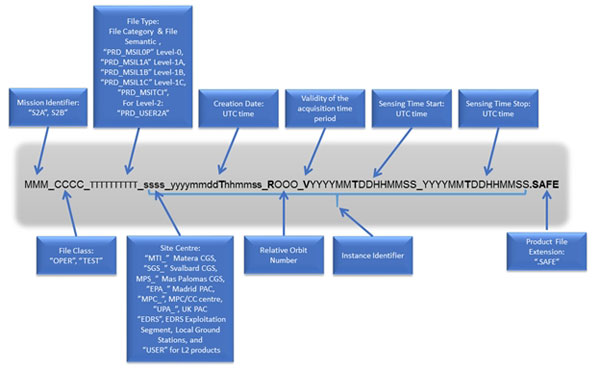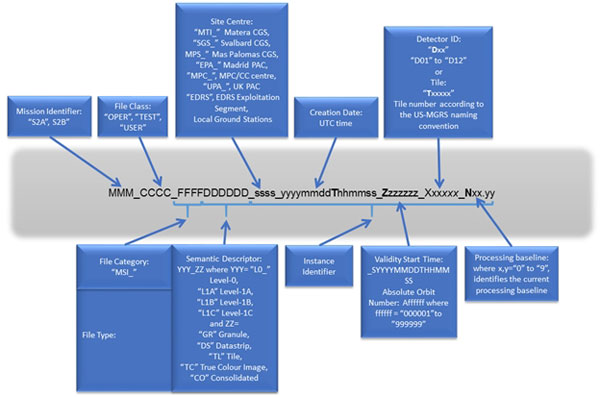Since December 6th, 2016, the SENTINEL-2 Level-1C products distributed by the DataHub are distributed in a new product format(1). This format has been introduced in order to overcome the 256 characters limitation on pathnames imposed by Windows platforms. This has been achieved by compaction of the filenames, including the naming of internal folders and files.
This product format is described in detail in the SENTINEL-2 Products Specification Document (PSD) (starting with the version 14.6). The product format corresponding to the Level-1C product combines the features described in the 'Compact Naming Convention' and the 'Complete Single Tile' sections in the PSD.
Compact Naming Convention
The compact naming convention is arranged as follows:
MMM_MSIXXX_YYYYMMDDHHMMSS_Nxxyy_ROOO_Txxxxx_<Product Discriminator>.SAFE
The products contain two dates.
- The first date (YYYYMMDDHHMMSS) is the datatake sensing time.
- The second date is the "<Product Discriminator>" field, which is 15 characters in length, and is used to distinguish between different end user products from the same datatake. Depending on the instance, the time in this field can be earlier or slightly later than the datatake sensing time.
The other components of the filename are:
- MMM: is the mission ID(S2A/S2B)
- MSIXXX: MSIL1C denotes the Level-1C product level/ MSIL2A denotes the Level-2A product level
- YYYYMMDDHHMMSS: the datatake sensing start time
- Nxxyy: the Processing Baseline number (e.g. N0204)
- ROOO: Relative Orbit number (R001 - R143)
- Txxxxx: Tile Number field
- SAFE: Product Format (Standard Archive Format for Europe)
Thus, the following filename:
S2A_MSIL1C_20170105T013442_N0204_R031_T53NMJ_20170105T013443.SAFE
Identifies a Level-1C product acquired by SENTINEL-2A on the 5th of January, 2017 at 1:34:42 AM. It was acquired over Tile 53NMJ(2) during Relative Orbit 031, and processed with Processing Baseline 02.04.
In addition to the above changes, a a TCI (True Colour Image) in JPEG2000 format is included within the Tile folder of Level-1C products in this format. For more information on the TCI, see the Definitions page.
(1) Reprocessed products - including those Reprocessed after 6 December - still use the old format Naming Convention (see below).
(2) The Tile Naming Convention is described in the 'Tiles and UTM Tiled Grid' section of the [PSD]. Download the Tiling Grid (in KML format).
________________________________________________________________________________________________
Old format Naming Convention for SENTINEL-2 Level-1C products generated before 6 December 2016:
The top-level SENTINEL-2 product folder name is composed of upper-case alphanumeric characters separated by an underscore (_).

Figure 1: Product naming convention
The Mission Identifier (MMM) denotes the satellite and will be either S2A for the SENTINEL-2A instrument or S2B for the SENTINEL-2B instrument.
The File Class (CCCC) may be set to "OPER" for all products generated during the Operations Phase. During Validation or internal testing, other values can be defined.
The File Type (TTTTTTTTTT) consist of the File Category and File Semantic
TTTTTTTTTT = FFFFDDDDDD where:
FFFF = File Category and DDDDDD = Semantic Descriptor.
The File Category comprises 3 characters and an ending underscore "_". This sub-field allows the definition of file groups characterised by related information / configuration information / generated data / usage of the data / etc. The Semantic Descriptor comprises 6 characters. The Semantic Descriptor can be composed of uppercase letters, digits or underscores. The File Type for a product may be "PRD_MSIL0P" for Level-0, "PRD_MSIL1A" for Level-1A, "PRD_MSIL1B" for Level-1B, "PRD_MSIL1C" for Level-1C, "PRD_MSITCI", or for Level-2A; "PRD_USER2A"
The Instance Identifier contains the Site Centre (ssss) and Creation Date in UTC time (yyyymmddThhmmss). The Site Centre denotes the file originator or processing facility. The Site Centre may be set to "MTI_" for Matera CGS, "SGS_" for Svalbard CGS, "MPS_" for Maspalomas CGS, "EPA_" for Madrid PAC, "MPC_" for the MPC/CC centre, "UPA_", for the UK PAC, "EDRS" for the EDRS Exploitation Segment, plus Local Ground Stations ending in "L", and "USER" for L2 products. A combination of additional fields may be included and are distinguished by the leading character:
The Relative Orbit Number (ROOO) where OOO represents the relative orbit number.
The Applicability Time Period: (VyyyymmddThhmmss_YYYYMMDDTHHMMSS) appends the Validity Period Time fields (Start and Stop).
The Product Format (SAFE) indicates that the product is in SENTINEL SAFE format.
Granule naming convention:

Figure 2: Granule (Granule and Tile) naming convention
Mission Identifier (MMM) and File Class (CCCCC) are as per the product naming convention.
The File Type (TTTTTTTTTT) consist of the File Category and File Semantic
TTTTTTTTTT = FFFFDDDDDD where:
FFFF = File Category and DDDDDD = Semantic Descriptor.
The File Category comprises 3 characters and an ending underscore "_". For Granules this value is set to "MSI_". The Semantic Descriptor DDDDDD = YYY_ZZ where YYY may be "L0_" for Level-0, "L1A" for Level-1A, "L1B" for Level-1B, "L1C" for Level-1C and ZZ may be "GR" for Granule, "DS" for Datastrip, "TL" for Tile, "TC" for True Colour Image, or "CO" for Consolidated.
The components of the Instance Identifier vary slightly when compared to the Product Naming Convention and may include:
The Applicability Start time (_Zzzzzz) = _SYYYYMMDDTHHMMSS Appends the Validity Start Time (granule)
or
The Absolute Orbit Number (_Zzzzzz) = _Affffff where ffffff is the Absolute Orbit Number (tile)
The Detector ID (_Xxxxxx) = Dxx where xx ranges from 01 to 12 (granule)
or
Tile Number (_Xxxxxx) = _Txxxxx which represents the Tile number according to the US-MGRS naming convention (tile)
The Processing Baseline Number (Nxx.yy) identifies the current processing baseline where x and y may be a digit ranging from 0 to 9.
File naming:
In addition to the fields above, filenames can include:
Band Index ID (Bxx) where xx is the band number
Completeness ID (Wx) where x = F for Full orbit x = P for Partial orbit
Degradation ID (Ly) where y = N for Nominal data y = D for Degraded data
Plus file extensions of .jp2 for JPEG2000 format image files, xml for metadata files, and .gml or Geographic Markup Language files